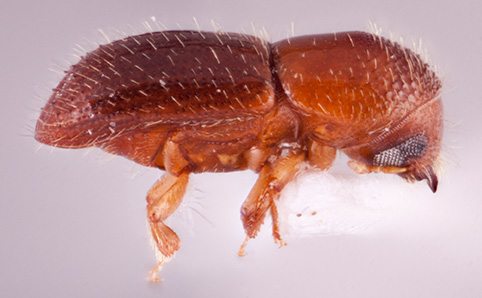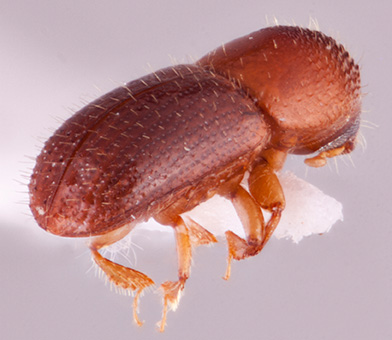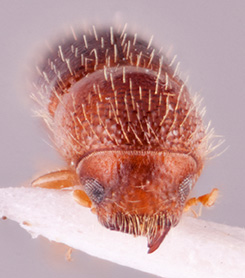Xyleborus affinis
|
Xyleborus affinis lateral; R.K. Osborn |
|
Xyleborus affinis dorsal; R.K. Osborn |
|
Xyleborus affinis declivity; R.K. Osborn |
|
Xyleborus affinis frontal; R.K. Osborn |
Taxonomic history
Xyleborus affinis Eichhoff, 1868b: 401.
Synonyms
Xyleborus affinis fuscobrunneus Eichhoff, 1878b: 372. Schedl 1959: 504.
Xyleborus affinis mascarensis Eichhoff, 1878b: 372. Wood 1960: 71.
Xyleborus affinis parvus Eichhoff, 1878b: 372. Wood 1960: 71.
Xyleborus sacchari Hopkins, 1915a: 64. Wood 1982: 830.
Xyleborus subaffinis Eggers, 1933a: 36. Schedl 1959: 504.
Xyleborus societatis Beeson, 1935a: 120. Beaver 1991: 94.
Xyleborus proximus Eggers, 1943: 66. Schedl 1963a: 331.
Diagnosis
2.2−2.5 mm long (mean = 2.32 mm; n = 5); 2.56−3.14 times as long as wide. This species is distinguished by the protibiaprotibia:
tibia of the first pair of legs
obliquely triangular, broadest at distaldistal:
situated away from the body
third; elytralelytral:
pertaining to the elytra
declivitydeclivity:
downward slope of either the pronotum or elytra
 shagreened, dull (specimen must be dry); small size; declivitaldeclivital:
shagreened, dull (specimen must be dry); small size; declivitaldeclivital:
pertaining to the elytral declivity
interstriae 1, 3 armed with sparse uniformly sized small granulesgranule:
a small rounded protuberance, like grains of sand
 , interstriaeinterstria:
, interstriaeinterstria:
longitudinal spaces along the elytra between the striae, which is not as<br />
impressed and bear smaller punctures.
 2 sparsely granulategranulate:
2 sparsely granulategranulate:
pertaining to a coarse, grainy surface texture
 at declivitaldeclivital:
at declivitaldeclivital:
pertaining to the elytral declivity
summit; and declivitydeclivity:
downward slope of either the pronotum or elytra
 not appearing sulcatesulcate:
not appearing sulcatesulcate:
deeply furrowed or grooved
.
May be confused with
Xyleborus cognatus, X. ferrugineus, X. festivus, X. perforans, X. pfeilii, and X. volvulus
Distribution
Probably native to tropical America (Wood 1977Wood 1977:
Wood SL. 1977. Introduced and exported American Scolytidae (Coleoptera). The Great Basin Naturalist 37: 67-74., Gohli et al. 2016Gohli et al. 2016:
Gohli J, Selvarajah T, Kirkendall LR, Jordal BH. 2016. Globally distributed Xyleborus species reveal recurrent intercontinental dispersal in a landscape of ancient worldwide distributions. BMC Evolutionary Biology 16: 37. https://doi.org/10.1186/s12862-016-0610-7), but now circumtropical. Less common in the Oriental region than in Africa and the Americas, but sometimes locally abundant. Recorded in the study region from India (Meghalaya, Tamil Nadu, no state recorded), Cambodia, China (Yunnan), Laos, Myanmar, Nepal, Taiwan, Thailand, Vietnam.
Host plants
strongly polyphagous (Schedl 1963aSchedl 1963a:
Schedl KE. 1963a. Scolytidae und Platypodidae Afrikas. Band II. Familie Scolytidae (Fortsetzung), Unterfamilie Ipinae (Fortsetzung). Revista de Entomologia de Moccedil;ambique 5: 1-594., as Xyleborus mascarensis Eichhoff, Wood 1982Wood 1982:
Wood SL. 1982. The bark and ambrosia beetles of North and Central America (Coleoptera: Scolytidae), a taxonomic monograph. Great Basin Naturalist Memoirs 8: 1-1359.)
Remarks
The biology of the species is reviewed by Schedl (1963a). Schneider (1987) notes that more than one generation may inhabit the same gallery system, and describes the oral mycangiamycangia:
structures used to carry fungal symbionts; highly morphologically variable
 . Seasonal changes in numbers caught in traps have been related to temperature and rainfall in Africa (Beaver and Löyttyniemi 1991, Madoffe and Bakke 1995Madoffe and Bakke 1995:
. Seasonal changes in numbers caught in traps have been related to temperature and rainfall in Africa (Beaver and Löyttyniemi 1991, Madoffe and Bakke 1995Madoffe and Bakke 1995:
Madoffe S, Bakke A. 1995. Seasonal fluctuations and diversity of bark and wood-boring beetles in lowland forest: implications for management practices. South African Forestry Journal 173: 9-15. https://doi.org/10.1080/00382167.1995.9629684) and in Central America (Rangel et al. 2012Rangel et al. 2012:
Rangel R, Peacute;rez M, Saacute;nchez S, Capello S. 2012. Population fluctuation of Xyleborus ferrugineus and X. affinis (Coleoptera: Curculionidae) in ecosystems of Tabasco, Mexico. Revista de Biologiacute;a Tropical 60: 1577-1588. https://doi.org/10.15517/rbt.v60i4.2075). Flight height preference in Amazonia is described by (Abreu et al. 2001Abreu et al. 2001:
Abreu RLS, Fonseca CRV, Guerrero JCH, Paula EVCM. 2001. Preferecirc;ncia de vocirc;o de nove espeacute;cies da famiacute;lia Scolytidae (Insecta: Coleoptera) na Amazocirc;nia Central. Acta Amazonica 31: 61-68. http://dx.doi.org/10.1590/1809-43922001311068 .). Laboratory rearing techniques, and the occurrence of delayed dispersal and alloparental care are discussed by Biedermann et al. (2009, 2011). Although its attacks are secondary, the species can be of economic importance due to its abundance and wide host range.
DNA data
Sequences available for COI and CAD.
COI: GU808696; MN620036; MN620037; MN620038; OP617763
CAD: GU808621; MN620302; MN620303; MN620304; MN620305; MN620306; MN620307; MN620308; OP607192





